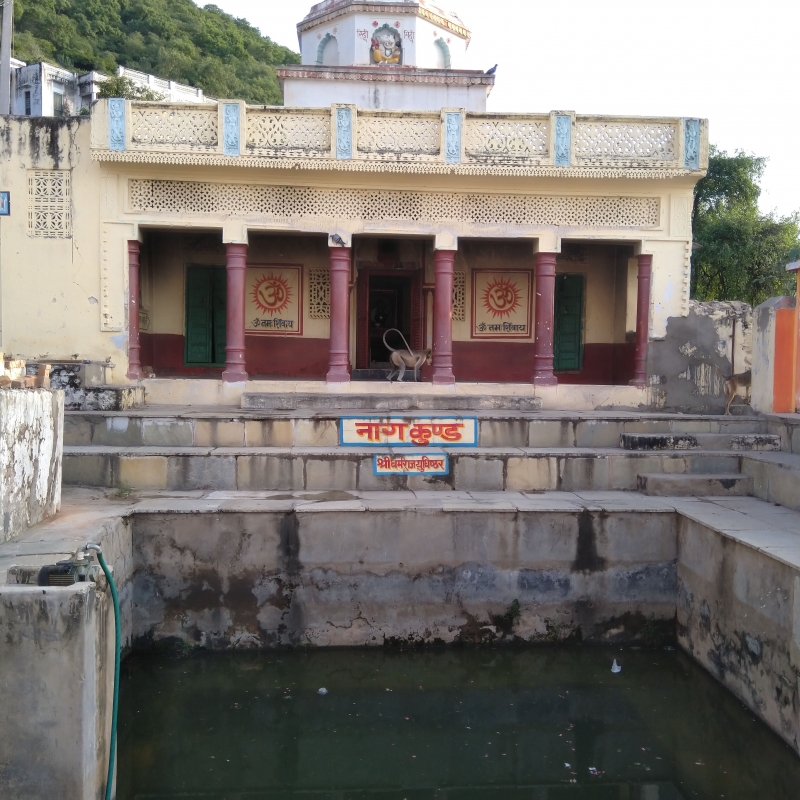A mammoth narrative, Mahabharata is roughly 10 times the length of the Iliad and the Odyssey combined, and about four times the length of Ramayana. It is also, however, much more than a purely textual tradition. Heard and told for centuries, it is intricately woven into the cultural fabric of India. It has permeated Indian languages and idioms, and is the basis of several art forms, festivals and traditions. It also has a ‘physical presence’ across India, with innumerable sites associated with the Pandavas, Draupadi and the great war of Kurukshetra.
How, then, should we understand and respond to Mahabharata? Is Mahabharata a story in the sense that Aesop’s Fables are stories?
Mahabharata describes itself and is recognised as ‘itihasa’. What is this Indian category of itihasa, and what can be understood about Mahabharata as itihasa? Importantly, what is Mahabharata’s place in our lives? Is it a fantastical story one hears for entertainment but does not take seriously? Is it history run wild on human imagination? Vyasa’s Mahabharata also includes the Gita. Is Mahabharata then a religious tradition, a Hindu tradition? And, finally, is there an original or authentic Mahabharata? Does it make sense to search for one? While reflecting on these questions about the Mahabharata, let us take as our point of reference the Mahabharata traditions as they exist in Rajasthan in all their myriad forms—as different retellings, as the basis of different art forms, and as traditions etched into the land. We must reflect on the incredible diversity of the Mahabharatas even within the relatively limited geographical space of a single state in India, Rajasthan, and what this diversity can tell us about the Mahabharata and our own understanding of this remarkable tradition.
Mahabharatas in Rajasthan
Padma Shri Komal Kothari’s work identifies that Rajasthan has multiple cultural zones, each with its own cuisine, diet, dialect, art forms and particular cultural elements. In that sense, there is no one Rajasthan with one language and one culture. This is also visible in the diversity of the Mahabharata traditions within Rajasthan itself.
Rajasthani Lok Mahabharata, by Sahitya Akademi award-winner and well-known Rajasthani writer Moolchand Pranesh, is a rare compilation of Mahabharata as it is sung and narrated by Kamadiyas, followers of Ramdevji, and Siddhs, who are concentrated in and around Bikaner and are followers of Jasnathji. These renderings of the Mahabharata, referred to locally as Pandavon ra rosa and Pandavon ra jhoda (War of the Pandavas), are part of the jagraatas and jammas held by the Kamadiyas and the Siddhs for their lok devatas Ramdevji and Jasnathji respectively.[1] They deviate from Vyasa’s Mahabharata on several important points—the mul (origin) of the Kuru dynasty is markedly different in this retelling; there is no episode of gambling; and it is Krishna who exiles the Pandavas after he is taken in by the words of Narad Muni, his trusted advisor. In Pranesh’s work the stories are presented in their original Marwari dialect, accompanied by an introduction in Hindi. While many familiar and possibly unsuitable tropes find their way into Pranesh’s interpretation and contextualisation of these stories, nonetheless, this compilation of local retellings in book form helps make these stories accessible to a much larger audience.
The Bhils of southern Rajasthan and northern Gujarat also have their own retellings of the Mahabharata. Mahabharata is of great significance for the Bhils, and is retold on important festivals and during specific rituals and social contexts. The storytellers of Bhilon ka Bharat, as it is called, can be male or female, and they must observe certain rituals, abstinences and fasting before and during the retelling. Perhaps the only written compilation and translation of this retelling of the Mahabharata is the well-known and widely respected Bhagwandas Patel’s Bhilon ka Bharat. An invaluable resource, it is the result of four years of fieldwork from 1984 to 1987. In this period, Bhagwandas Patel collected hours and hours of recordings in Khedbrahma tehsil in northern Gujarat and Kotra tehsil in southern Rajasthan, and witnessed the special place of Bhilon ka Bharat among the Bhils. In his introduction to the tradition and to his own fieldwork in the Aravalis, Patel explains the great significance of Mahabharata in the lives of Bhils. Depending on their content and context, different episodes are traditionally retold at important moments such as marriages and at the last rites of the departed.
Pandun ka kada (Pandavas’ couplets) is another Mahabharata tradition of Rajasthan and is also intricately connected to specific communities, the Jogis and Meos of Mewat. The Jogis and Meos are Muslim communities who have traditionally rendered Pandun ka kada and other stories on occasions such as weddings, festivals and childbirth. The Meos were Rajputs who converted to Islam centuries ago. Their culture includes Islamic and Hindu practices, and they trace their lineage to characters such as Bheema and Arjuna. In Pandun ka kada, Krishna is a minor character, and the tradition is strongly influenced by the Gorakhnath panth (sect), of whom the Jogis have been traditional followers.[2]
Mahabharata in Art Forms
In addition to numerous retellings of the Mahabharata, stories from the epic are important content for folk as well as classical art forms. Pad (a performance art form of the Hadouti region) renders several stories from Mahabharata, and as an art form itself remains heartily popular, drawing enthusiastic audiences in the thousands.[3] (Fig. 1)
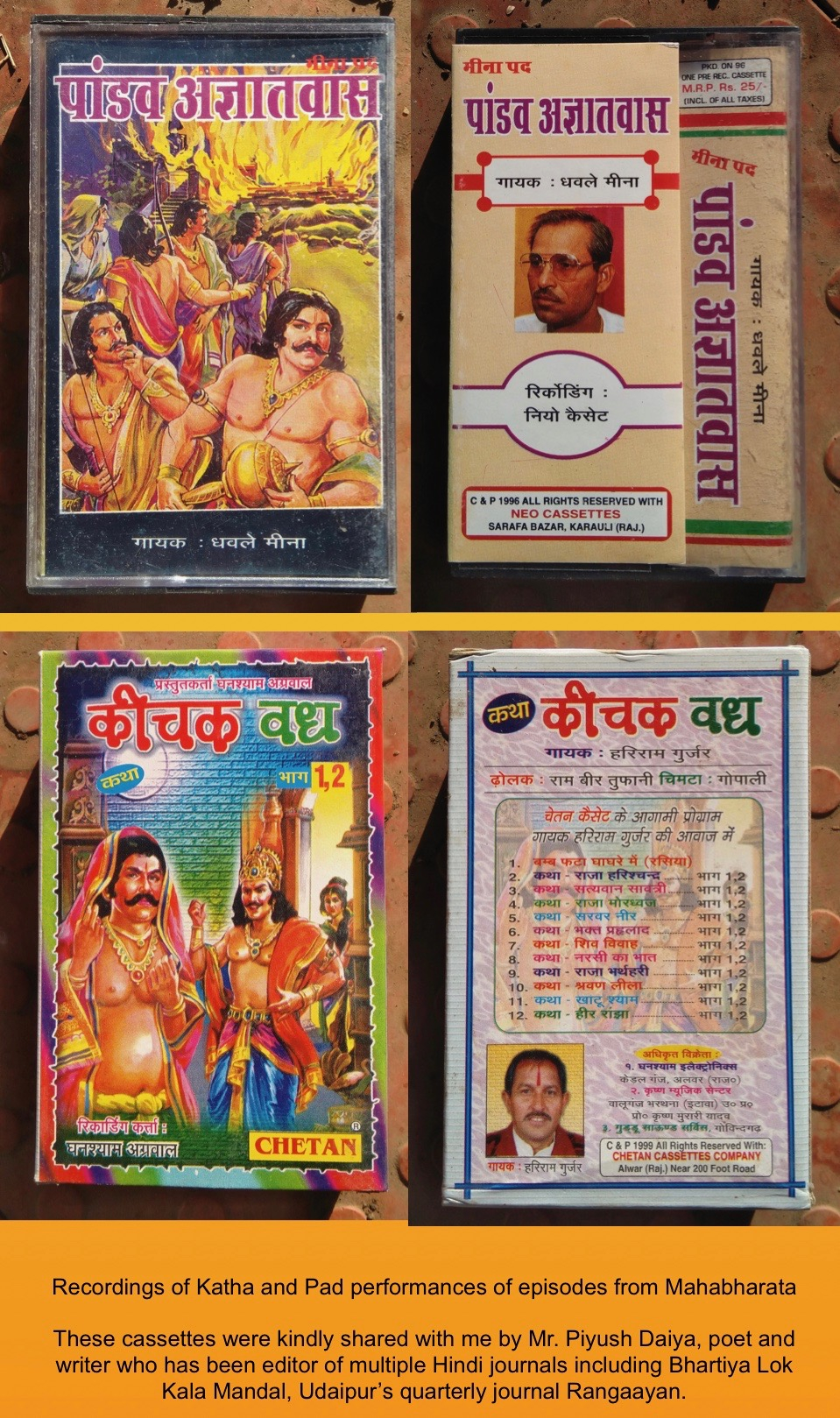
Kathas (the narration of episodes interspersed with songs) retelling the story of Khatushyamji are another instance of a popular art form retelling stories from Mahabharata. (Fig. 2) These kathas tell the story of Barbareek (Bhima’s grandson), who sets out for Kurukshetra to join his grandfather and granduncles in their war. Krishna, who knows all, sees that Barbareek is coming, and that his participation in the war could change everything. Disguised as a Brahmin, he sits under a peepul tree along Barbareek’s path to Kurukshetra, and engages him in a conversation, demanding a display of his prowess in archery. The consequence of this exchange between Krishna and Barbareek is the little-known episode of Barbareek’s severed head being placed on a hill overlooking the battlefield, wherefrom he witnessed the entire Kurukshetra war, and on being given a vardaan (boon) by Krishna, came to be known and revered as Khatu ke Shyam (Krishna of Khatu).
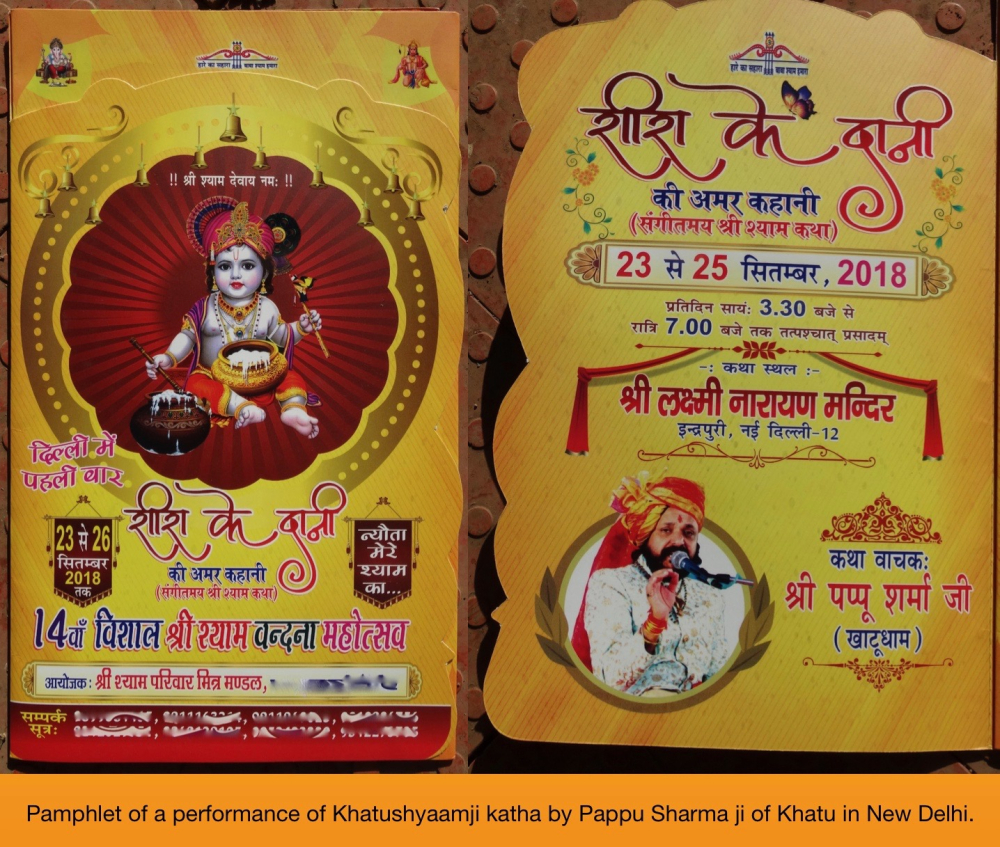
As the popularity of Khatushyamji has grown, his story is retold all over India and the world as a YouTube animated series and as popular katha performances. (Fig. 3) These katha performances were also recorded and distributed in cassette form, increasing their accessibility. In addition to the story of Khatushyamji, recording studios in Rajasthan, Haryana and Uttar Pradesh also recorded katha performances of multiple Mahabharata episodes by local artists and distribute these recordings in the audio cassettes ubiquitous in Indian markets until recently. The artists attracted large audiences and would often be called to far-flung places to perform. One such artist who enjoys widespread popularity today is Papu Sharma of Khatu, who performs the story of Khatu ke Shyam.
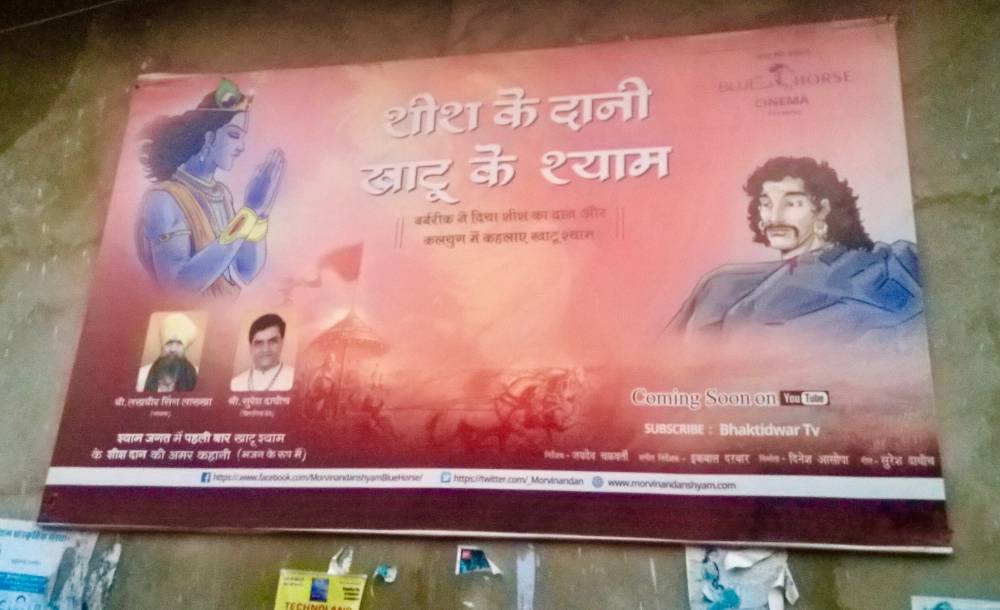
Mahabharata—Etched into the Land
The Mahabharata, a long, rambling, reflective narrative that often dives into side stories before turning back to the events that led to the great war between the Pandavas and Kauravas, seems always immediately available anywhere in India. Every village, or every third village at most, has a rock, hill, footprint, cave, temple or kund (waterbody) related to Mahabharata. The Pandavas and Kauravas, Krishna, Barbareek and Draupadi are our own home-grown heroes, whose dress and speech change in each region’s imagination. In Rajasthan as well, Mahabharata is etched into the land and its several retellings are full of local references and sensibilities. (Fig. 4)
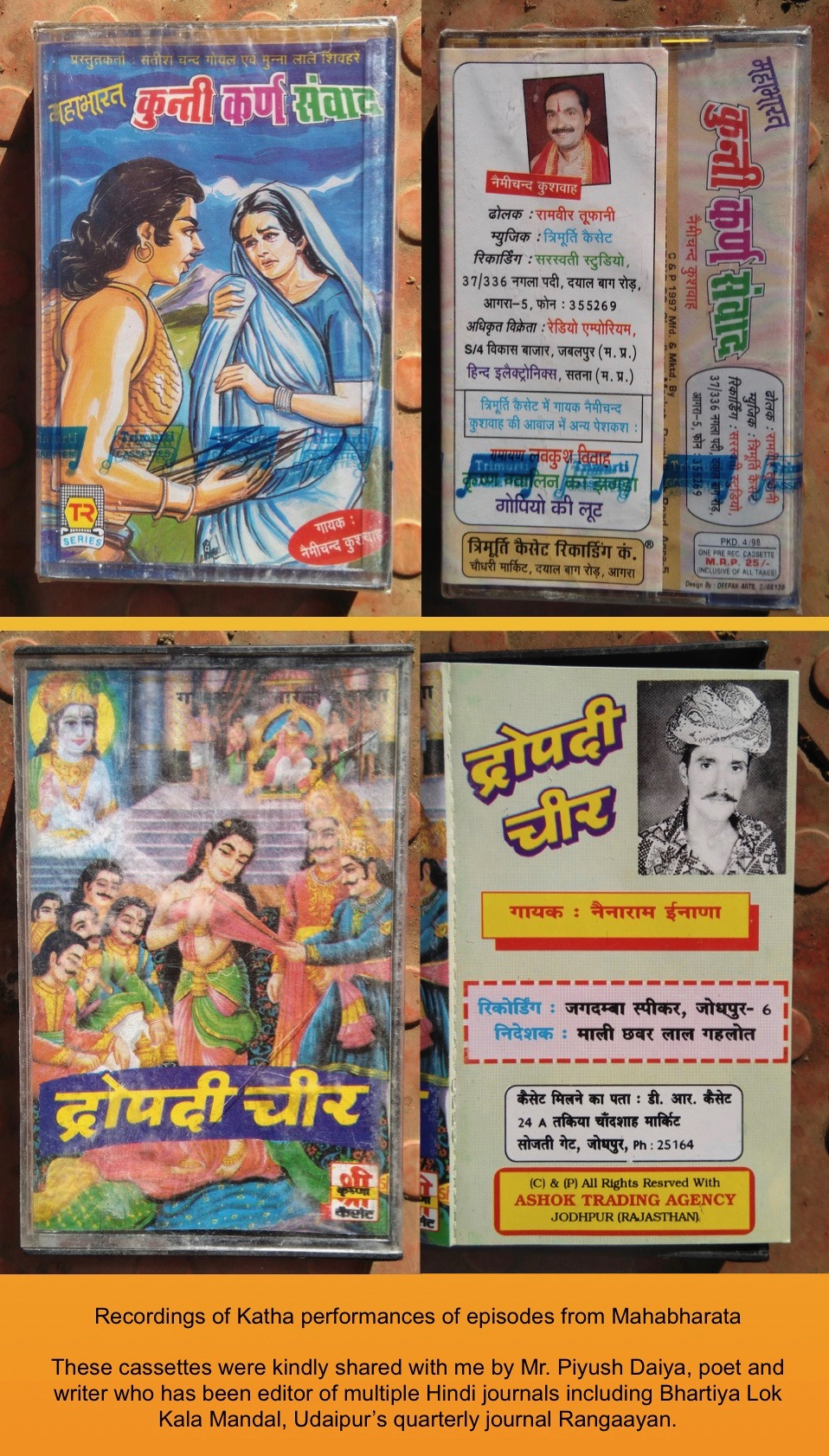
Pandupol in Sariska is said to be where the Pandavas took refuge during their years of vanvaas (exile into the forest), and Viratnagar close by is perhaps the most well-known site in Rajasthan associated with Mahabharata. Present-day Viratnagar is said to have been Matsya Raj, the kingdom of Raja Virat, famous for his enormous gaudhan (wealth in the form of cattle). The Pandavas spent the last year of their vanvaas (exile) here, which had the added condition of being a year of agyatvaas (anonymous living). They defended Raja Virat’s gaudhan when it was attacked by Duryodhana’s army, and because of their unmistakable skill and valour in the battlefield, were discovered here during their year of agyaatvaas. In present-day Viratnagar town, two caves are well-known, one as the palace of Bheema and the other Pandavas, and the other as the palace of Kichaka, Raja Virat’s brother-in-law, who was killed by Bheema for molesting Draupadi.
Another story is of Lohargal Dham, which is related not only to the Pandavas but also to Parshurama, Surya Dev and Vishnu. It is said that after their victory at Kurukshetra, the Pandavas were weighed down by their paapa (sin) of bloodshed, of killing their own brethren and gurus. They sought Krishna’s advice, and he instructed them to travel to all the tirthas (pilgrimage sites), assuring them that they will come upon a tirtha where their weapons would dissolve in the tirtha’s water, and it would be from there that they would become free from their paapa and attain mukti. After visiting several tirthas, the Pandavas reached Lohargal; they bathed here in the ancient Surya Kund and immersed their weapons in the water. As Krishna had said, so it happened, and the weapons dissolved into the water. The Pandavas, overjoyed, knew that at last they had become free of their paapa. They did tapasya (meditation) to Shiva and attained mukti at Lohargal.
This moment after the Kurukshetra war was not the first time the Pandavas visited a tirtha sthana (place of pilgrimage). In the years of their vanvaas, they were advised by their uncle Vidura to visit Pushkar, the adi-tirtha (original sacred waterbody) of all tirthas. Today, there are five small kunds inside the old Ganesh temple complex near Nag Pahad in Pushkar. Each of the five kunds is said to have been created by the tapasya of one of the Pandavas. Yudhistir did tapasya to Nag Devta and created Nag Kund, Bheema did tapasya to Surya Dev and created Surya Kund; similarly, Arjun did tapasya to Ganga Maiyya, Nakul did tapasya to Padam, and Sahdev did tapasya to Chakra (Vishnu).
A few kilometres from the Panchh Kund is Pandeshwar Mahadev, a Shiva temple said to have been made by the Pandavas. Shiva, pleased with the Pandavas, had given them the vardaan that wherever they go, their sthaan would be made. As an instance of the ever-changing nature of these sites, a small temple dedicated to Krishna and the Pandavas and their wife Draupadi was constructed in 2016 near the largest of the panchh (five) kunds, that of Dharmaraja Yudhisthir, to cater to visiting devotees who look for a place to do puja while they were at the kunds.
Many Mahabharatas—What do we make of them?
This question is not new. As Europeans began arriving in India in the sixteenth and seventeenth centuries, they encountered the Indian subcontinent’s multitude of languages, communities, practices and traditions. In their attempt to make sense of the culture, so markedly different from their own, Europeans set out to understand and document the religion, beliefs, social structure, laws and history of Indians. Itihasa traditions such as Mahabharata and Ramayana, seeped into the regions and communities of India, were also subjects of this study, and colonial scholars first launched Mahabharata studies under the rubric of two major disciplines, history and literature/philology.
In their search for Indian history, Europeans looked for dates and genealogies in Mahabharata. They inquired into its origins, date of its compilation, its author, and its philosophical and moral teachings. These attempts faced roadblocks on many fronts due to the sheer scope of the Mahabharata, its internal contradictions, its ‘strange’ and fantastical genealogies and reigns, and its several textual compilations in different Indian languages—most of which contradicted each other on multiple points. Mahabharata came across to Europeans as ‘history abounding with kings thirty feet high and reigns thirty thousand years long, and geography made of seas of treacle and seas of butter’[4] riddled with impossible events and inconsistencies. Mahabharata was thus seen by Europeans as a flawed history, an attempt by Indians to document events, which had been taken over by the over-fertile imagination of the natives. According to this European understanding of theMahabharata, historical events such as a battle between local kings in present-day Haryana (the Kurukshetra war) was embellished over centuries by Indian imaginations and finally became the Mahabharata as Europeans encountered it—a massive narrative abounding with warriors who could summon and defeat the devas and knowledgeable rishi munis (sages) who could defy the laws of gravity and the human body. The many traditions of Mahabharata across India came to be seen as that many interpolations, layers added on to and thus obscuring the original.
In order to ascertain the ‘true history’ of India as told by the Mahabharata, European scholars, civil servants of the British East India Company and missionaries from across the Christian world began a mammoth effort to locate the true, original Mahabharata—or at least its earliest textual compilation, which they believed would be closest to the truth. Indians took on this project as well, and continued it.
One of the most extensive and well-known of the efforts to find the ‘original’ Mahabharata began in 1919, two years after the inception of the Bhandarkar Oriental Research Institute (BORI) in Pune in 1917, and culminated in 1966, when the BORI critical edition of Mahabharata[5] was released by then President of India, Dr Sarvapalli Radhakrishnan. In the making of this critical edition, 1,259 manuscripts in multiple languages were consulted over decades, and a purportedly ‘complete’, ‘accurate’ edition of Mahabharata was made available for the first time.
Despite the scope and scale of this effort, and the consequent availability of a ‘complete’ and ‘accurate’ Mahabharata, this critical edition, and others like it, have remained a preserve of academics—Indologists, Sanskritists and historians—as have the allied questions about historical authenticity and factual accuracy of events in the Mahabharata. It would seem as though the several communities of India to whom the several Mahabharata traditions belong have no interest in this complete and accurate Mahabharata, and they continue to maintain and enrich their own multiple Mahabharata traditions, even as they remain very much aware that there are many Mahabharatas apart from their own—some very similar, others drastically different.
Why this difference in approaches to the tradition? Why are the multitudes of communities in India not bothered by this multiplicity of Mahabharatas?
The first step in understanding this difference in approaches is to recognise the roots of what are today common-sense ideas about the Mahabharata—that it is (flawed) history, literature (epic or mythology, whichever category we choose), and/or a religious text/tradition of the Hindus. As with the idea of the Mahabharata as history, the orientalist study of Mahabharata shaped colonial and, later, Indian understandings of Mahabharata traditions in particular ways.
Before taking on these ideas, we must ask: Are these categories, such as history, applicable to the Mahabharata? Does it make sense to interpret Mahabharata the way scholars and students of literature interpret texts such as Hamlet or The Lord of the Rings? And finally, can the attitude shared by communities across the length and breadth of India, which is so much in contrast to the formal, academic and mainstream attitude towards the Mahabharata, tell us something about what Mahabharata is?
What if Mahabharata and, by extension, itihasa traditions are not history or literature, but something else entirely? [6]
Notes
[1] Jagraatas or jammas are overnight gatherings on festivals and auspicious days where rituals are performed, the life stories of lok devatas—Ramdevji or Jasnathji in this case—are retold, and lok kathas, such as local renderings of Mahabharata and Ramayana are sung or narrated.
[2] To read more about Panduon ke kada and the Meos of Mewat who render this retelling, refer to the article on Panduon ke kada, which is a part of this module on Mahabharata and can be accessed from the module homepage.
[3] These details about pad and fascinating recordings of pad performances of Mahabharata episodes such as Abhimanyu ki shaadi (Abhimanyu’s marriage) were kindly shared with me by Dr Madan Meena, an independent researcher and painter and honorary director of the Adivasi Academy, Tejgadh, Gujarat. Dr Meena has been documenting art forms and traditions of Rajasthan for more than 15 years.
[4] Macaulay, ‘Minute on Education (1835).'
[5] To know more about BORI’s mammoth Mahabharata project and for a complete list of the 19 volumes released to date, see: ‘The Bhandarkar Oriental Research Institute : Mahabharata Project.’
[6] This idea has been proposed and developed by S.N. Balagangadhara, as an opening into his writings on the nature of itihasa traditions in particular, and Indian traditions in general, see: Balagangadhara, ‘What Do Indians Need, a History or the Past?’; ‘How to Speak for the Indian Traditions.’
Bibliography
Balagangadhara, S. N. ‘How to Speak for the Indian Traditions: An Agenda for the Future.’ Journal of the American Academy of Religion 73, no. 4 (December 1, 2005): 987–1013.
———. ‘What Do Indians Need, a History or the Past? A Challenge or Two to Indian Historians, Parts I and II’. Lecture presented at the 7th Maulana Abul Kalam Azad Memorial Lecture, Indian Council for Historical Research, New Delhi, November 11, 2014. Accessed January 14, 2020. https://www.academia.edu/9462514/What_Do_Indians_Need_a_History_or_the_Past_A_challenge_or_two_to_Indian_historians_Parts_I_and_II.
‘Minute on Education (1835) by Thomas Babington Macaulay.’ Accessed January 14, 2020. http://www.columbia.edu/itc/mealac/pritchett/00generallinks/macaulay/txt_minute_education_1835.html.
‘The Bhandarkar Oriental Research Institute : Mahabharata Project.’ Accessed January 14, 2020. http://www.bori.ac.in/mahabharata_project.html.
